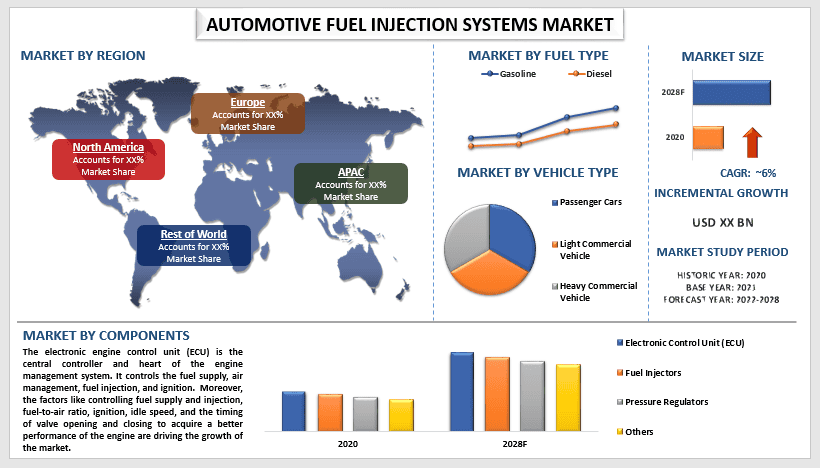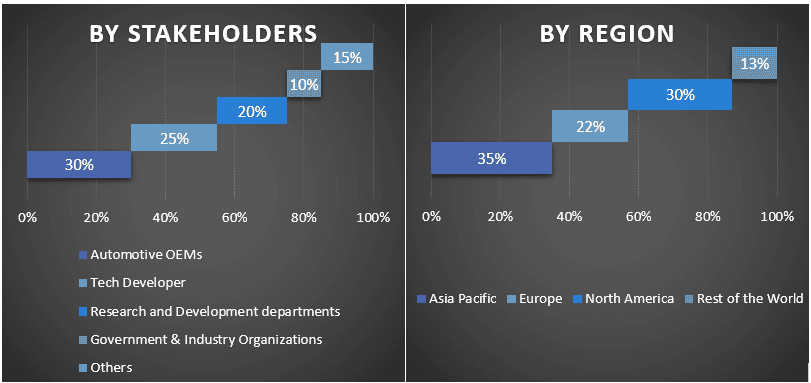
글로벌 자동차 연료 분사 시스템 시장은 예측 기간 동안 약 6%의 상당한 성장률을 보일 것으로 예상됩니다.엔진에 이상적인 양의 연료를 공급하기 위한 기계적 및 전자적 회로의 조합이 자동차 연료 분사 시스템입니다. 또한, 스로틀 응답 증가, 모든 RPM에서 적절한 동력 제공, 적절한 공기 및 연료 혼합물을 제공하여 콜드 스타트 문제 제거와 같은 요인이 이 시장의 성장을 주도하고 있습니다. 따라서, 이러한 요인들이 시장 성장을 견인하고 있습니다. 자동차 연료 분사는 연료와 공기가 챔버에 들어가기 전에 잘 혼합되도록 합니다. 또한, 엔진 출력 및 효율을 극대화하면서 가스 소비를 줄이는 요인들이 있습니다. 연료 분사 시스템은 일반적으로 일관되고 부드러운 스로틀 응답과 더 나은 배출 기준을 제공하는 데 활용됩니다. 일부 주요 업체들은 환경에 더 효율적인 연료 인젝터를 개발하기 위해 노력하고 있습니다.예를 들어, 2021년 12월, 주요 자동차 부품 설계 및 제조 회사인 Napino Auto & Electronics Ltd는 고유한 산소 센서 기술을 보유한 미국 기반 회사인 Kerdea Technologies Inc와 협력 관계를 발표했습니다. 이 회사의 센서 기술이 Napino로 이전되어 BSVI(Bharat Stage Emission Standards) 체제에서 인도 자동차 산업의 요구 사항을 충족할 것입니다..
Robert Bosch GmbH, Aptiv PLC, Denso Corporation, Hitachi Ltd, Carter Fuel System, Edelbrock LLC, NGK SPARK PLUG CO LTD, Magneti Marelli S.p.A, Infineon Technologies AG, Keihin Corporation 등이 시장의 주요 업체입니다. 이러한 업체들은 첨단 혁신적인 제품/기술을 고객에게 제공하기 위해 여러 M&A와 파트너십을 체결했습니다.
보고서에 제시된 통찰
“구성 요소 중, 전자 제어 장치 범주가 예측 기간 동안 강력한 연평균 성장률을 보일 것입니다”
구성 요소에 따라 시장은 전자 제어 장치(ECU), 연료 인젝터, 압력 조절기 등으로 세분화됩니다. 전자 제어 장치(ECU)는 예측 기간 동안 더 높은 연평균 성장률을 보일 것입니다. 전자 엔진 제어 장치(ECU)는 엔진 관리 시스템의 중앙 컨트롤러이자 핵심입니다. 연료 공급, 공기 관리, 연료 분사 및 점화를 제어합니다. 또한, 연료 공급 및 분사, 공기 대 연료 비율, 점화, 아이들 속도, 밸브 개폐 타이밍을 제어하여 엔진 성능을 향상시키는 요인이 시장 성장을 주도하고 있습니다.
“차량 유형 중, 승용차가 2020년에 시장에서 상당한 점유율을 차지할 것입니다”
차량 유형에 따라 시장은 승용차, 경상용차 및 대형 상용차로 분류됩니다. 이 중 승용차가 2020년 시장에서 상당한 점유율을 차지합니다. 또한, 도시 인구의 소득 증가, 기술 발전, 운송 비용 증가, 편안함에 대한 선호도, 안전성이 높은 첨단 승용차의 증가가 시장의 유망한 성장을 이끄는 요인입니다.
“연료 유형 중, 가솔린 범주가 2020년에 시장에서 상당한 점유율을 차지합니다”
연료 유형에 따라 시장은 가솔린과 디젤로 분류됩니다. 이 중 가솔린이 2020년 시장에서 상당한 점유율을 차지합니다. 또한, 가솔린은 더 효율적이고 배출량이 적습니다. 또한, 가솔린은 마일리지가 더 많고 엔진의 효율성과 성능을 향상시키기 위해 공기와 쉽게 혼합되는 경향이 있습니다.
“아시아 태평양이 시장에서 상당한 점유율을 차지할 것입니다”
2020년, 아시아 태평양 지역은 글로벌 자동차 연료 분사 시스템 시장에서 상당한 점유율을 차지했습니다. 강력하고 유망한 산업 참여자의 존재로 인해, 이 지역은 예상 기간 동안 선두를 차지할 것으로 예상됩니다. 또한, 특히 중국 및 인도와 같은 국가에서 가처분 소득과 구매력이 증가함에 따라 예측 기간 동안 빠른 속도로 성장할 것으로 예상되며, 이는 자동차 연료 분사 시장 점유율을 견인하고 있습니다. 이 지역의 관광 산업 성장 또한 시장의 유망한 성장의 원인입니다.
이 보고서를 구매해야 하는 이유:
- 이 연구는 인증된 주요 업계 전문가가 검증한 시장 규모 및 예측 분석을 포함합니다.
- 이 보고서는 전체 산업 성과를 한눈에 볼 수 있도록 간략하게 요약합니다.
- 이 보고서는 주요 비즈니스 재무, 제품 포트폴리오, 확장 전략 및 최근 개발에 중점을 두고 주요 산업 동료에 대한 심층 분석을 제공합니다.
- 산업에서 우세한 동인, 제약, 주요 트렌드 및 기회를 상세하게 조사합니다.
- 이 연구는 다양한 세그먼트별로 시장을 포괄적으로 다룹니다.
- 산업에 대한 심층적인 지역별 분석.
사용자 정의 옵션:
글로벌 자동차 연료 분사 시스템 시장은 요구 사항이나 다른 시장 세그먼트에 따라 추가로 맞춤화할 수 있습니다. 이 외에도 UMI는 귀하의 고유한 비즈니스 요구 사항이 있음을 이해하므로 귀하의 요구 사항에 완벽하게 맞는 보고서를 받으려면 언제든지 문의하십시오.
목차
자동차 연료 분사 시스템 시장 분석을 위한 연구 방법론 (2022-2028)
글로벌 자동차 연료 분사 시스템 시장의 채택을 생성 및 분석하기 위해 수행된 세 가지 주요 단계는 과거 시장 분석, 현재 시장 추정, 글로벌 주요 지역의 미래 시장 예측이었습니다. 과거 시장 수치를 수집하고 현재 시장 규모를 추정하기 위해 광범위한 2차 연구가 수행되었습니다. 둘째, 이러한 통찰력을 검증하기 위해 수많은 조사 결과와 가정이 고려되었습니다. 또한, 글로벌 자동차 연료 분사 시스템 시장의 가치 사슬 전반에 걸쳐 업계 전문가들과 광범위한 1차 인터뷰가 수행되었습니다. 1차 인터뷰를 통해 시장 수치를 가정하고 검증한 후, 전체 시장 규모를 예측하기 위해 상향식/하향식 접근 방식을 사용했습니다. 그 후, 시장 세분화 및 데이터 삼각 측량 방식을 채택하여 관련 산업의 세그먼트 및 하위 세그먼트의 시장 규모를 추정하고 분석했습니다. 자세한 방법론은 아래에 설명되어 있습니다.
과거 시장 규모 분석
1단계: 2차 출처에 대한 심층 연구:
자동차 연료 분사 시스템 시장의 과거 시장 규모를 얻기 위해 다음과 같은 회사 내부 출처를 통해 상세한 2차 연구가 수행되었습니다.연간 보고서 및 재무 제표, 성과 발표, 보도 자료 등,그리고 다음을 포함한 외부 출처저널, 뉴스 및 기사, 정부 간행물, 경쟁사 간행물, 부문 보고서, 타사 데이터베이스 및 기타 신뢰할 수 있는 간행물.
2단계: 시장 세분화:
자동차 연료 분사 시스템 시장의 과거 시장 규모를 얻은 후, 주요 지역의 서로 다른 세그먼트 및 하위 세그먼트에 대한 과거 시장 통찰력 및 점유율을 수집하기 위해 상세한 2차 분석을 수행했습니다. 주요 세그먼트는 구성 요소, 차량 유형 및 연료 유형으로 보고서에 포함되어 있습니다. 또한, 해당 지역의 전체 테스트 모델 채택을 평가하기 위해 국가 수준 분석이 수행되었습니다.
3단계: 요인 분석:
다양한 세그먼트 및 하위 세그먼트의 과거 시장 규모를 확보한 후, 자동차 연료 분사 시스템 시장의 현재 시장 규모를 추정하기 위해 상세한요인 분석을 수행했습니다. 또한, 자동차 연료 분사 시스템 시장의 구성 요소, 차량 유형 및 연료 유형과 같은 종속 및 독립 변수를 사용하여 요인 분석을 수행했습니다. 전 세계 자동차 연료 분사 시스템 시장 부문에서 최고 파트너십, 인수 합병, 사업 확장 및 제품 출시를 고려하여 수요 및 공급 측면 시나리오에 대한 철저한 분석을 수행했습니다.
현재 시장 규모 추정 및 예측
현재 시장 규모:위의 3단계에서 얻은 실행 가능한 통찰력을 바탕으로, 현재 시장 규모, 글로벌 자동차 연료 분사 시스템 시장의 주요 업체, 세그먼트의 시장 점유율에 도달했습니다. 필요한 모든 점유율 분할 및 시장 세분화는 위에 언급된 2차 접근 방식을 사용하여 결정되었으며, 1차 인터뷰를 통해 검증되었습니다.
추정 및 예측:시장 추정 및 예측을 위해, 이해 관계자에게 제공되는 동인 및 트렌드, 제약 및 기회를 포함한 다양한 요인에 가중치가 할당되었습니다. 이러한 요인을 분석한 후, 관련 예측 기술, 즉 상향식/하향식 접근 방식을 적용하여 전 세계 주요 시장 전반의 다양한 세그먼트 및 하위 세그먼트에 대한 2028년 시장 예측에 도달했습니다. 시장 규모를 추정하기 위해 채택된 연구 방법론은 다음과 같습니다.
- 국내 주요 시장 전반의 매출(USD) 및 자동차 연료 분사 시스템 시장의 채택률 측면에서 산업의 시장 규모
- 모든 시장 세그먼트 및 하위 세그먼트의 모든 비율 점유율, 분할 및 분석
- 제공되는 제품 측면에서 글로벌 자동차 연료 분사 시스템 시장의 주요 업체. 또한, 빠르게 성장하는 시장에서 경쟁하기 위해 이러한 플레이어가 채택한 성장 전략
시장 규모 및 점유율 검증
1차 조사:주요 지역의 최고위급 임원 (CXO / VP, 영업 책임자, 마케팅 책임자, 운영 책임자, 지역 책임자, 국가 책임자 등)을 포함한 주요 의견 리더 (KOL)와 심층 인터뷰를 실시했습니다. 1차 조사 결과를 요약하고 통계 분석을 수행하여 명시된 가설을 입증했습니다. 1차 조사의 입력은 2차 결과와 통합되어 정보를 실행 가능한 통찰력으로 전환했습니다.
다양한 지역의 1차 참여자 분할

시장 공학
데이터 삼각 측량 기법을 사용하여 전체 시장 추정을 완료하고 글로벌 자동차 연료 분사 시스템 시장의 각 세그먼트 및 하위 세그먼트에 대한 정확한 통계 수치를 도출했습니다. 데이터는 글로벌 자동차 연료 분사 시스템 시장의 구성 요소, 차량 유형 및 연료 유형 영역의 다양한 매개변수 및 추세를 연구한 후 여러 세그먼트 및 하위 세그먼트로 분할되었습니다.
글로벌 자동차 연료 분사 시스템 연구의 주요 목표
연구에서 글로벌 자동차 연료 분사 시스템 시장의 현재 및 미래 시장 추세를 정확히 지적했습니다. 투자자는 연구에서 수행된 정성적 및 정량적 분석을 기반으로 투자를 결정하는 데 전략적 통찰력을 얻을 수 있습니다. 현재 및 미래 시장 추세는 지역 수준에서 시장의 전반적인 매력을 결정하여 산업 참여자가 미개척 시장을 활용하여 선구자 이점을 얻을 수 있는 플랫폼을 제공합니다. 연구의 다른 정량적 목표는 다음과 같습니다:
- 가치 (USD) 측면에서 자동차 연료 분사 시스템 시장의 현재 및 예상 시장 규모를 분석합니다. 또한 다양한 세그먼트 및 하위 세그먼트의 현재 및 예상 시장 규모를 분석합니다.
- 연구의 세그먼트에는 구성 요소, 차량 유형 및 연료 유형 영역이 포함됩니다.
- 자동차 연료 분사 시스템에 대한 규제 프레임워크의 정의 및 분석
- 다양한 중개인의 존재와 관련된 가치 사슬을 분석하고 업계의 고객 및 경쟁사 행동을 분석합니다.
- 주요 지역에 대한 자동차 연료 분사 시스템 시장의 현재 및 예상 시장 규모를 분석합니다.
- 보고서에서 연구된 주요 지역 국가는 아시아 태평양, 유럽, 북미 및 기타 지역을 포함합니다.
- 자동차 연료 분사 시스템 시장의 회사 프로필 및 빠르게 성장하는 시장에서 지속하기 위해 시장 참여자가 채택한 성장 전략
- 심층 지역 수준의 산업 분석
관련 보고서
이 상품을 구매한 고객님들도 함께 구매하신 상품










